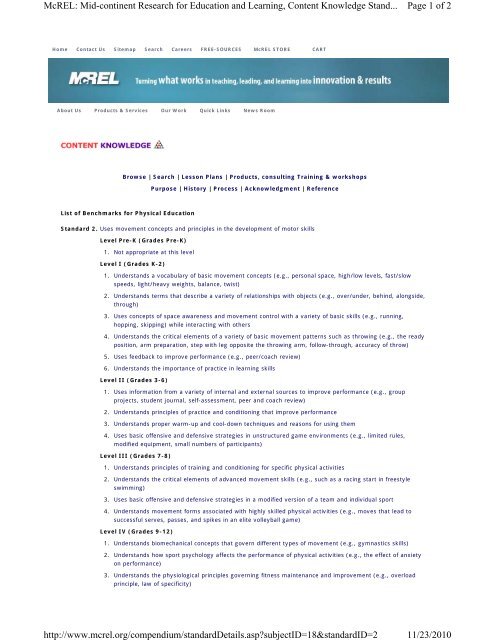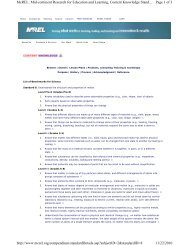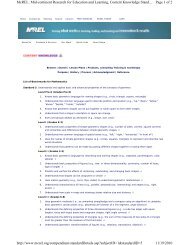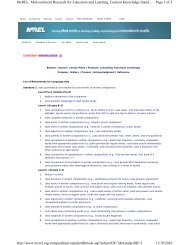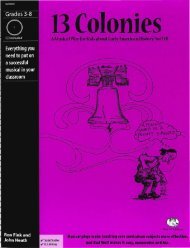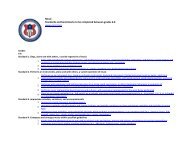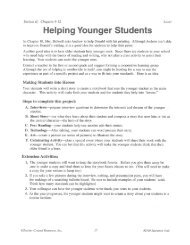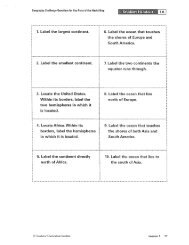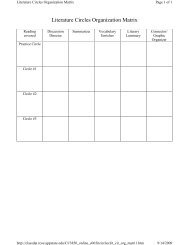McREL Phy Ed Standard 2
McREL Phy Ed Standard 2
McREL Phy Ed Standard 2
Create successful ePaper yourself
Turn your PDF publications into a flip-book with our unique Google optimized e-Paper software.
<strong>McREL</strong>: Mid-continent Research for <strong>Ed</strong>ucation and Learning, Content Knowledge Stand...http://www.mcrel.org/compendium/standardDetails.asp?subjectID=18&standardID=2Page 1 of 211/23/2010Home Contact Us Sitemap Search Careers FREE-SOURCES <strong>McREL</strong> STORE CARTAbout Us Products & Services Our Work Quick Links News RoomBrowse | Search | Lesson Plans | Products, consulting Training & workshopsPurpose | History | Process | Acknowledgment | ReferenceList of Benchmarks for <strong>Phy</strong>sical <strong>Ed</strong>ucation<strong>Standard</strong> 2. Uses movement concepts and principles in the development of motor skillsLevel Pre-K (Grades Pre-K)1. Not appropriate at this levelLevel I (Grades K-2)1. Understands a vocabulary of basic movement concepts (e.g., personal space, high/low levels, fast/slowspeeds, light/heavy weights, balance, twist)2. Understands terms that describe a variety of relationships with objects (e.g., over/under, behind, alongside,through)3. Uses concepts of space awareness and movement control with a variety of basic skills (e.g., running,hopping, skipping) while interacting with others4. Understands the critical elements of a variety of basic movement patterns such as throwing (e.g., the readyposition, arm preparation, step with leg opposite the throwing arm, follow-through, accuracy of throw)5. Uses feedback to improve performance (e.g., peer/coach review)6. Understands the importance of practice in learning skillsLevel II (Grades 3-6)1. Uses information from a variety of internal and external sources to improve performance (e.g., groupprojects, student journal, self-assessment, peer and coach review)2. Understands principles of practice and conditioning that improve performance3. Understands proper warm-up and cool-down techniques and reasons for using them4. Uses basic offensive and defensive strategies in unstructured game environments (e.g., limited rules,modified equipment, small numbers of participants)Level III (Grades 7-8)1. Understands principles of training and conditioning for specific physical activities2. Understands the critical elements of advanced movement skills (e.g., such as a racing start in freestyleswimming)3. Uses basic offensive and defensive strategies in a modified version of a team and individual sport4. Understands movement forms associated with highly skilled physical activities (e.g., moves that lead tosuccessful serves, passes, and spikes in an elite volleyball game)Level IV (Grades 9-12)1. Understands biomechanical concepts that govern different types of movement (e.g., gymnastics skills)2. Understands how sport psychology affects the performance of physical activities (e.g., the effect of anxietyon performance)3. Understands the physiological principles governing fitness maintenance and improvement (e.g., overloadprinciple, law of specificity)
<strong>McREL</strong>: Mid-continent Research for <strong>Ed</strong>ucation and Learning, Content Knowledge Stand...http://www.mcrel.org/compendium/standardDetails.asp?subjectID=18&standardID=2Page 2 of 211/23/20104. Uses offensive and defensive strategies and appropriate rules for sports and other physical activitiesSign up for <strong>McREL</strong> FREE SOURCES Privacy Policy Disclaimer


